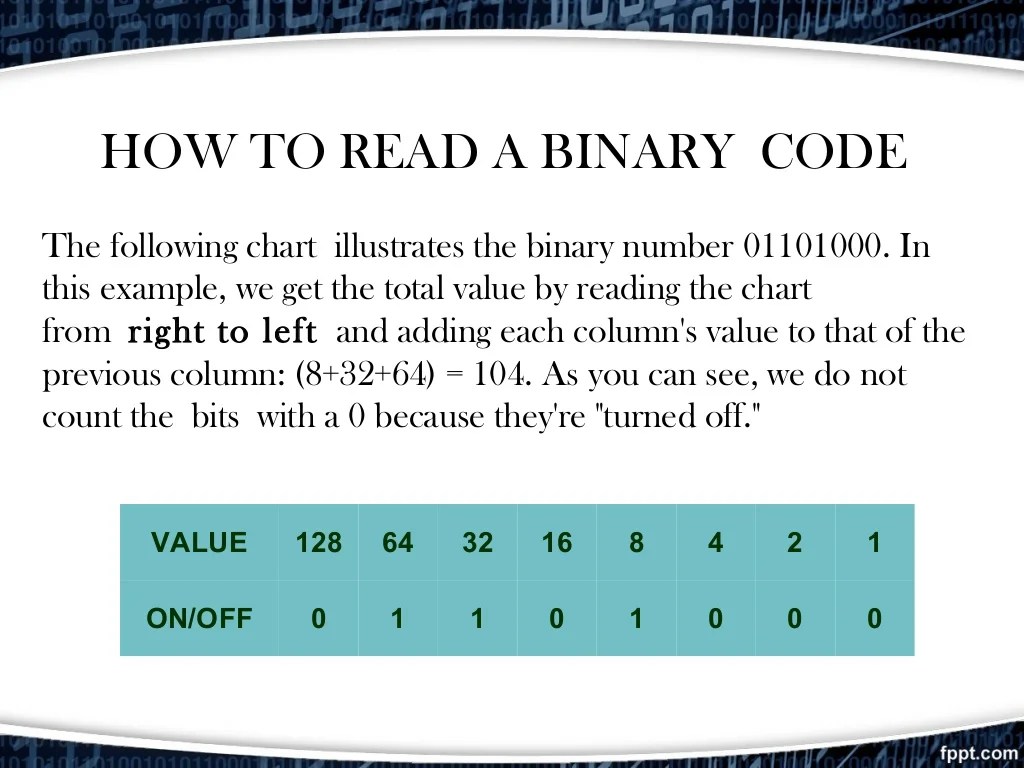00001001 = (2 3 + 2 0 = 8 + 1 = 9). Web so, to get the value of 2, the first bit would be turned off, and the second bit would be turned on, for a binary value of 10. with binary, it's important to realize you. On user input, 2 values are compared and are set up as a binary heap. What is leading zeros in binary? Match it up to the example.
$1$ $2\cdot 1+1=3$ $2\cdot 3+0=6$ $2\cdot. Web so, to get the value of 2, the first bit would be turned off, and the second bit would be turned on, for a binary value of 10. with binary, it's important to realize you. The rightmost place number being zero. So, the binary sequence 00001001 is the decimal number 9. On user input, 2 values are compared and are set up as a binary heap.
Start at the left, and then each time you move rightward, you double your previous total and add the current digit. However, if you are looking at a binary number, say 10110011, you would typically start from the right, as the bit on the right is. // read the next bit. Web each digit in a binary number has weight = 2 ^ position where position starts from right to left. It reads bits from the stream one at a time, starting from the least significant bit of the first byte:
00001001 = (2 3 + 2 0 = 8 + 1 = 9). Binary is still read from left to right. On user input, 2 values are compared and are set up as a binary heap. Web algol 68's elem operator is effectively msb 1 bit numbering as the bits are numbered from left to right, with the first bit (bits elem 1) being the most significant bit, and the. Web remember, binary is read from right to left. They are numbered from lowest weight (the lowest weight bit getting the number 0 or 1 depending on the convention. What is leading zeros in binary? It reads bits from the stream one at a time, starting from the least significant bit of the first byte: Web binary numbers can be read off in hexadecimal but not in octal. Web the leftmost bit in a byte is the biggest. $1$ $2\cdot 1+1=3$ $2\cdot 3+0=6$ $2\cdot. Web bits are not numbered from right to left. Web here is a simple read wrapper using an int buffer. A leading zero is any 0 digit that comes. // read the next bit.
However, If You Are Looking At A Binary Number, Say 10110011, You Would Typically Start From The Right, As The Bit On The Right Is.
Web so, to get the value of 2, the first bit would be turned off, and the second bit would be turned on, for a binary value of 10. with binary, it's important to realize you. These are weights for byte 128 64 32 16 8 4 2 1 so for the following. The rightmost place number being zero. Start at the left, and then each time you move rightward, you double your previous total and add the current digit.
00001001 = (2 3 + 2 0 = 8 + 1 = 9).
They are numbered from lowest weight (the lowest weight bit getting the number 0 or 1 depending on the convention. Binary is still read from left to right. // read the next bit. So, the binary sequence 00001001 is the decimal number 9.
Web Numbers Can Be Placed To The Left Or Right Of The Point, To Show Values Greater Than One And Less Than One.
Web the leftmost bit in a byte is the biggest. What is leading zeros in binary? Web here is a simple read wrapper using an int buffer. $1$ $2\cdot 1+1=3$ $2\cdot 3+0=6$ $2\cdot.
Web I Have A Simple Piece Of Code That Reads An Array Of Values.
On user input, 2 values are compared and are set up as a binary heap. Web bits are not numbered from right to left. Web each digit in a binary number has weight = 2 ^ position where position starts from right to left. Match it up to the example.



:max_bytes(150000):strip_icc()/what-is-binary-and-how-does-it-work-4692749-3-bf612555b7054e0f9dcff0d5bd9606a3.png)




:max_bytes(150000):strip_icc()/what-is-binary-and-how-does-it-work-4692749-5-488677c840f3424c83da05ded39a0d72.png)
